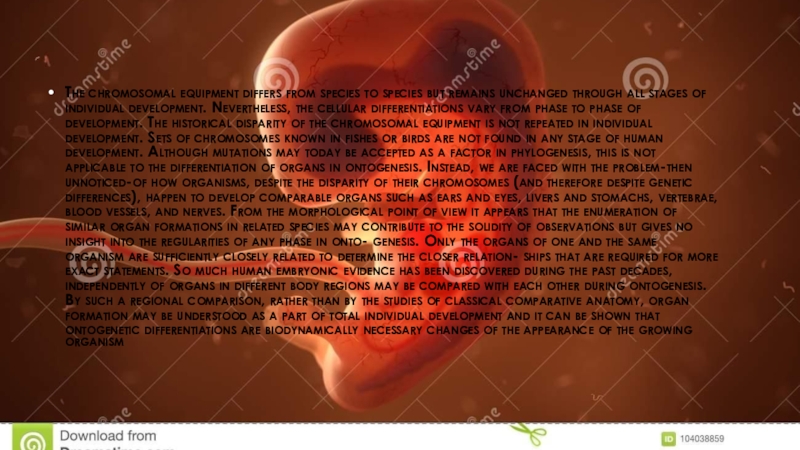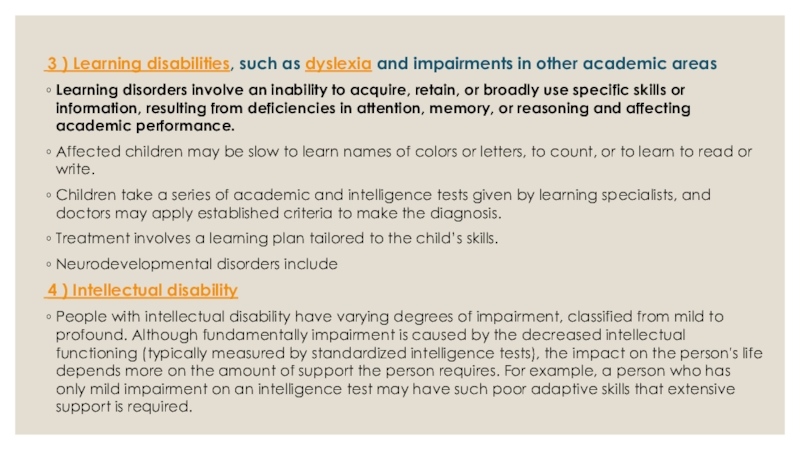Слайд 1THE RELATIONSHIP oF PHYLOGENESIS AND ONTOGENESIS
NAME – Deepanshi Deswal
Satyam Rawat
GROUP NO.
– 192- B
SUPERVISED BY – SVETLANA SMIRNOVA
Слайд 2ONTOGENESIS
the development of an individual organism or anatomical or behavioral
feature from the earliest stage to maturity.
Ontogeny is the developmental
history of an organism within its own lifetime, as distinct from phylogeny, which refers to the evolutionary history of a species. In practice, writers on evolution often speak of species as "developing" traits or characteristics. This can be misleading. While developmental (i.e., ontogenetic) processes can influence subsequent evolutionary (e.g., phylogenetic) processes(evolutionary developmental biology and recapitulation theory), individual organisms develop (ontogeny), while species evolve (phylogeny).
Слайд 3PHYLOGENESIS
Phylogenesis is the biological process by which a taxon (of any rank) appears.
The science that studies these processes is called phylogenetics.
Phylogenetic relationships are
discovered through phylogenetic inference methods that evaluate observed heritable traits, such as DNA sequences or overall morpho-anatomical, ethological, and other characteristics.
Слайд 5RELATIONSHIP OF ONTOGENEIS AND PHYLOGENEIS
Two of the concepts thus
represent historical disciplines; as indicated by Haeckel we may presume
that «Ontogeny», as the history of the individual organism, stands for a description of the ontogenetic development of living forms. If «Phylogeny» is to stand for the genealogy of the taxon Biota it may be represented by a phylogenetic classification. The relation between these two concepts was stated in the famous «bio gene- tic law»: Ontogeny is a recapitulation of phylogeny.
Слайд 6The chromosomal equipment differs from species to species but remains
unchanged through all stages of individual development. Nevertheless, the cellular
differentiations vary from phase to phase of development. The historical disparity of the chromosomal equipment is not repeated in individual development. Sets of chromosomes known in fishes or birds are not found in any stage of human development. Although mutations may today be accepted as a factor in phylogenesis, this is not applicable to the differentiation of organs in ontogenesis. Instead, we are faced with the problem-then unnoticed-of how organisms, despite the disparity of their chromosomes (and therefore despite genetic differences), happen to develop comparable organs such as ears and eyes, livers and stomachs, vertebrae, blood vessels, and nerves. From the morphological point of view it appears that the enumeration of similar organ formations in related species may contribute to the solidity of observations but gives no insight into the regularities of any phase in onto- genesis. Only the organs of one and the same organism are sufficiently closely related to determine the closer relation- ships that are required for more exact statements. So much human embryonic evidence has been discovered during the past decades, independently of organs in different body regions may be compared with each other during ontogenesis. By such a regional comparison, rather than by the studies of classical comparative anatomy, organ formation may be understood as a part of total individual development and it can be shown that ontogenetic differentiations are biodynamically necessary changes of the appearance of the growing organism

Слайд 8FORMS OF PHYLOGENESIS
THERE ARE 3 FORMS :
ANABOLY
ARKHALLAKIS
ANABOLISM
Слайд 9DIVERGENCE
divergence pertains to an evolutionary process wherein a population of an inbreeding species diverges into
two or more descendant species that have become more and
more dissimilar in terms of forms and structures.
This divergence results from their adaptation to their environment. An example of this is the development of wings in bats from the same bones that form the arm and hand (or paw) in other mammals. Another example is a flock of bird in migration. The flock gets divided since half of them would settle to a new island while the other half continued migrating to a farther land. In due time, the two groups adapt to their new habitat and develop new characteristics that enable them to survive. Eventually, they become different species to their ancestors. Thus, what was once one species diverged into two. This process is also called divergent evolution. It is in contrast to another evolutionary process, convergence (i.e. convergent evolution)
Слайд 10CONVERGENCE AND CONCURRENCY
convergence pertains to an evolutionary process wherein organisms evolve
structures that have similar (analogous) structures or functions in spite
of their evolutionary ancestors being very dissimilar or unrelated. It is also called convergent evolution.
It exhibits when totally unrelated species living ion the same habitat exhibits common features , it includes adaptive convergence .
Examples of Convergent Evolution
Streamlined body shape of dolphins, sharks and (extinct) ichthyosaurs. The evolution of echolocation in whales and bats. The paired shell shape of bivalve mollusks and brachiopods. The silk producing ability of spiders, silk worms, silk moths and weaver ants.
Слайд 13PHYLUM CHORDATA
Chordates evolved a unique body plan within deuterostomes and
are considered to share five morphological characters, a muscular postanal
tail, a notochord, a dorsal neural tube, an endostyle, and pharyngeal gill slits.
The prevailing view holds that the phylum Chordata consists of three subphyla: Urochordata (Tunicata), Cephalochordata and Vertebrata . All three groups are characterized by possession of a notochord, a dorsal, hollow neural tube (nerve cord), branchial slits, an endostyle, myotomes and a postanal tail. These characters will be discussed later in relation to evolutionary scenarios for chordates. Meanwhile, the Chordata belongs to the superphyletic Deuterostomia, together with the phyla Echinodermata and Hemichordata . Chordates are thought to have originated from a common ancestor (or ancestors) of the deuterostome
Слайд 14Birds comprises the class aves they have feathers evolved from
reptilian scales , they are flexible and very strong for
their light weight . The anterior limbs are modified for flight , the posterior pair for walking , swimming , etc. the feathers protect the body , decreases the water loss through the body surface , decrease the loss of the body heat and aid in flying by presenting a plane surface to the air
They have compact streamlined body and bones fused to form pneumatic type air filled bones
Example is archaeopteryx is the intermediate between reptiles and birds . The jaw of the birds are hollow containing large air sacs they are endothermic warm blooded animals , adapted to variety of environment
Humans comes under Mammalia, they have hair , mammary glands , differentiated teeth and they maintain constant body temperature
Birds and mammals are the only animals that are endotherms.
Слайд 15Developmental disorders in humans
Developmental disorders are better called neurodevelopmental disorders.
Neurodevelopmental disorders are neurologically based conditions that can interfere with
the acquisition, retention, or application of specific skills or sets of information. They may involve dysfunction in attention, memory, perception, language, problem-solving, or social interaction. These disorders may be mild and easily manageable with behavioral and educational interventions, or they may be more severe and affected children may require more support.
Слайд 161 ) Attention-deficit/hyperactivity disorder.
ADHD is a brain disorder that is present
from birth or develops shortly after birth.
Some children mainly have
difficulty with sustained attention, concentration, and ability to complete tasks; some children are overactive and impulsive; and some are both.
Doctors use questionnaires completed by parents and teachers as well as observations of the child to make the diagnosis.
Psychostimulant or other drugs plus structured environments, routines, a school intervention plan, and modified parenting techniques are often needed.
2) Autism spectrum disorders
Autism spectrum disorders are conditions in which people have difficulty developing normal social relationships, use language abnormally or not at all, and show restricted or repetitive behaviors.
Neurodevelopmental disorders include
Слайд 17 3 ) Learning disabilities, such as dyslexia and impairments in other
academic areas
Learning disorders involve an inability to acquire, retain, or
broadly use specific skills or information, resulting from deficiencies in attention, memory, or reasoning and affecting academic performance.
Affected children may be slow to learn names of colors or letters, to count, or to learn to read or write.
Children take a series of academic and intelligence tests given by learning specialists, and doctors may apply established criteria to make the diagnosis.
Treatment involves a learning plan tailored to the child’s skills.
Neurodevelopmental disorders include
4 ) Intellectual disability
People with intellectual disability have varying degrees of impairment, classified from mild to profound. Although fundamentally impairment is caused by the decreased intellectual functioning (typically measured by standardized intelligence tests), the impact on the person's life depends more on the amount of support the person requires. For example, a person who has only mild impairment on an intelligence test may have such poor adaptive skills that extensive support is required.

Слайд 18
5 ) Rett Syndrome
Rett syndrome is a rare neurodevelopmental disorder caused by
a genetic problem that occurs almost exclusively in girls and
affects development after an initial 6-month period of normal development.
Rett syndrome is caused by a genetic mutation.
Symptoms include a decline in language and social skills after an initial period of normal development.
Diagnosis is based on a doctor's observation of the child’s early growth and development and genetic testing.
Treatment involves a multidisciplinary approach that is focused on the management of symptoms and educational support.